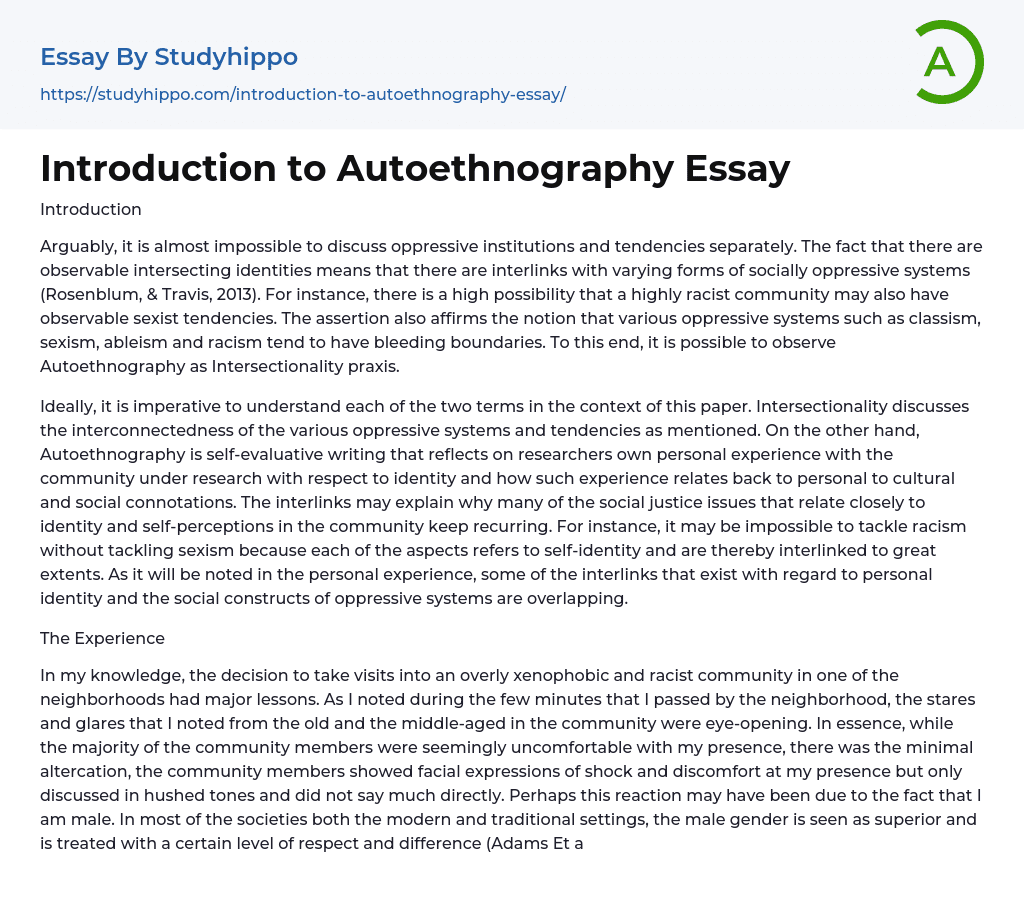Introduction
Arguably, it is almost impossible to discuss oppressive institutions and tendencies separately. The fact that there are observable intersecting identities means that there are interlinks with varying forms of socially oppressive systems (Rosenblum, & Travis, 2013). For instance, there is a high possibility that a highly racist community may also have observable sexist tendencies. The assertion also affirms the notion that various oppressive systems such as classism, sexism, ableism and racism tend to have bleeding boundaries. To this end, it is possible to observe Autoethnography as Intersectionality praxis.
Ideally, it is imperative to understand each of the two terms in the context of this paper. Intersectionality discusses the interconnectedness of the various oppressive systems and tendencies as mentioned. On the other hand, Autoethnography is self-evaluative writing that reflects on research
...ers own personal experience with the community under research with respect to identity and how such experience relates back to personal to cultural and social connotations. The interlinks may explain why many of the social justice issues that relate closely to identity and self-perceptions in the community keep recurring. For instance, it may be impossible to tackle racism without tackling sexism because each of the aspects refers to self-identity and are thereby interlinked to great extents. As it will be noted in the personal experience, some of the interlinks that exist with regard to personal identity and the social constructs of oppressive systems are overlapping.
The Experience
In my knowledge, the decision to take visits into an overly xenophobic and racist community in one of the neighborhoods had major lessons. As I noted during the few minutes that I passed by the neighborhood, the stares and glares that
noted from the old and the middle-aged in the community were eye-opening. In essence, while the majority of the community members were seemingly uncomfortable with my presence, there was the minimal altercation, the community members showed facial expressions of shock and discomfort at my presence but only discussed in hushed tones and did not say much directly. Perhaps this reaction may have been due to the fact that I am male. In most of the societies both the modern and traditional settings, the male gender is seen as superior and is treated with a certain level of respect and difference (Adams Et al., 2013). However, on of the known facts is that there have been extents of gender-based violence in this particular community targeting women especially local women.
As a social worker, one of the reasons for my curiosity with the particular community was based on the fact that there have been such cases of gender-based violence in the particular community. To this end, I have a feeling that if the scenario was a reverse setting and I was a female passerby the reaction from the community would have been different. The stares and glares may have graduated to the physical altercation, and I would have most likely been roughed up by the community members. On the same note passing by an opening ground dominated by boys chances are I would have been harassed in more than one way. The fact that the experience was pensive and tense and based on my color and perceived otherness only means that it would have been worse had I been a female.
Intersectionality
Intersectionality in definition refers to the apparent interlinks
between socially constructed behaviors and tendencies with regard to various perceived aspects of otherness. In the particular experience, it is notable that xenophobia and racism may also be connected to classism and sexism. In essence, the fact that the members of this community perceive members of my racial community as superior and better off economically and socially may be a key contributor to the classist view in the society. However, the community members also tend to have an aspect of indifference with regard to color. The indifference is the main reason there are racism and extents of xenophobia, essentially, a community that has notable issues with self-identity will most certainly have other underlying cases of oppressive tendencies. In most instances, a community that feels inferior also attempts to develop divisions and classes at the local level. For instance, in the particular neighborhood apart from the evident cases of racism and xenophobia, there are possible cases of classism and sexism that may not be necessarily notable at a first glance.
The Intersectionality theory argues that each time one oppressive behavior is notable in a system it is more that probable that there are more interlinking tendencies in the community (Mehrotra, 2010). To this end, the reflection of individual identities must establish the other interlinking behaviors that from part of the community. Research indicates that self-identity is a perceived issue, meaning that it can be a perception that is unfounded. However, research also indicates that ultimately the party that has an inferior or superior complex will in most instances cause a ripple effect at a different level of engagement.
References
- Adams, M., Blumenfeld, W. J., Castañeda, C. R., Hackman, H.
W., Peters, M. L., &Zúñiga, X. (2013).Readings for diversity and social justice (3rd ed.). New York, NY: Routledge.
- Aesthetics essays
- Art History essays
- Artist essays
- ballet essays
- Body Art essays
- Color essays
- Concert Review essays
- Creativity essays
- Cultural Anthropology essays
- Ethnography essays
- Harlem Renaissance essays
- Heritage essays
- Modernism essays
- Mona Lisa essays
- Pastoral essays
- Postmodernism essays
- Realism essays
- Symbolism essays
- Theatre essays
- Visual Arts essays
- Voice essays
- Work of art essays
- African American essays
- African American Culture essays
- American Values essays
- Asian American essays
- Chinese essays
- Ethnicity essays
- Ethnocentrism essays
- German essays
- Han Chinese essays
- Hispanic essays
- Identity essays
- Korean essays
- Mexican essays
- Nation essays
- Native American essays
- Race and Ethnicity essays
- White People essays




